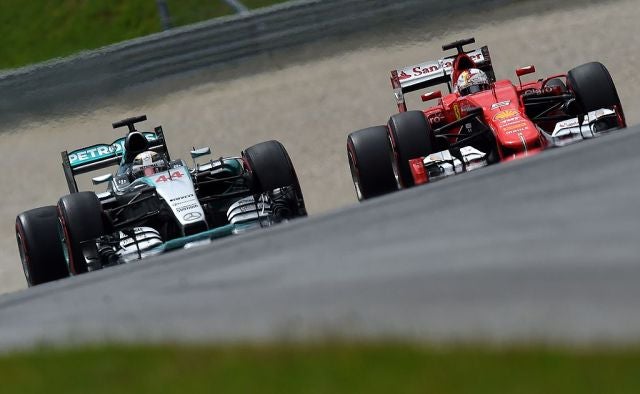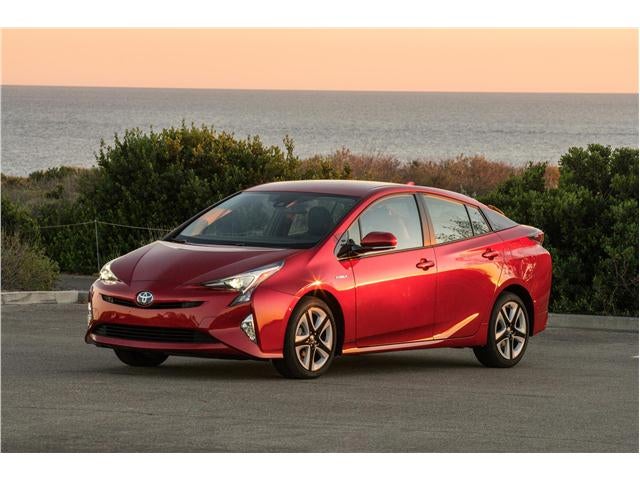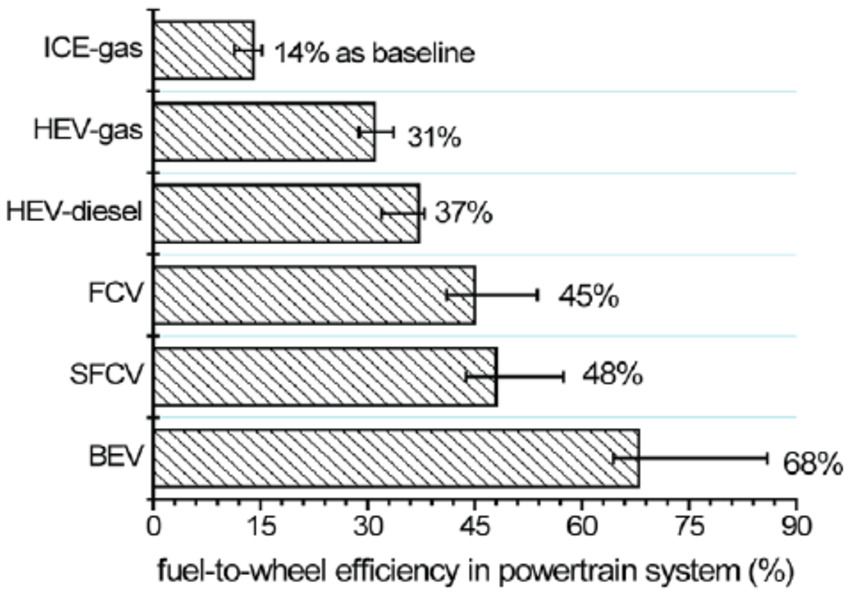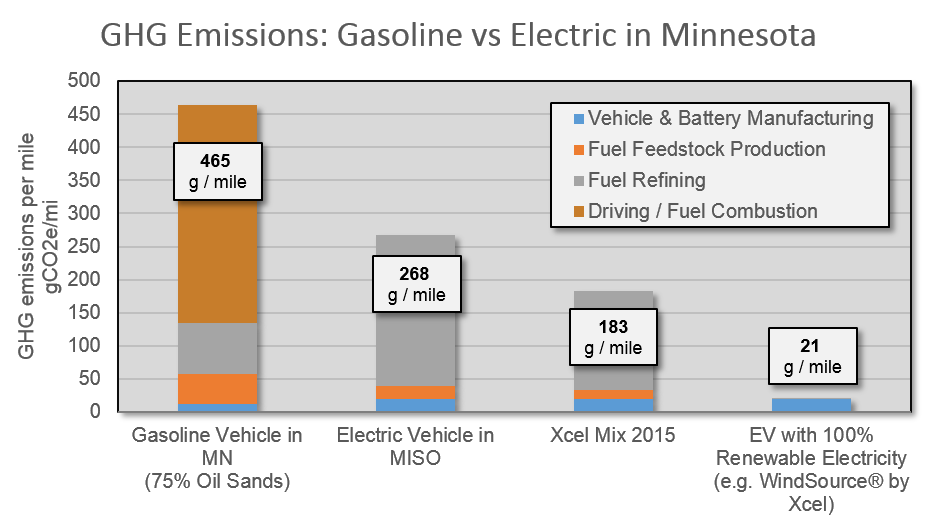 by "punkgoose17" (punkgoose17)
by "punkgoose17" (punkgoose17)
Published 11/27/2017 at 13:50
 by "punkgoose17" (punkgoose17)
by "punkgoose17" (punkgoose17)
Published 11/27/2017 at 13:50
Tags: Energy Efficiency
STARS: 2
This topic came up over Thanksgiving, so I was curious what the energy efficiency of vehicle is. These numbers are all very rough, but they should still be interesting. Also these are energy efficiency, so the more hp you are using the more energy you are using.
Some sources
https://www.e-education.psu.edu/egee102/node/1944
!!! UNKNOWN CONTENT TYPE !!!
!!! UNKNOWN CONTENT TYPE !!!

Car (.81)(.25 engine)(.70 transmission*) = 14%
More efficient car (.81)(.27 engine)(.84 transmission*) = 18%
*I don’t believe the 50% number based on the 15% rule for dynos.
Hybrid car (.81)(.39 engine)(.84 transmission*) = 27%
F1 car (.81 **)(.47 engine)(.89 transmission) = 34%
** I know an F1 car does not run on pump gas.
Coal Power Plant to Electric Car:
Electric Car (.31)(.89 charging and battery)(.9 motor)(.9 drivetrain) = 22%
Electric Car new power plant (.96 coal extraction)(.98 coal transportation)(.9 boiler)(.47 turbine***)(.95 generator)(.95 transmission of electricity)(.89 charging and battery)(.9 motor)(.9 drivetrain) = 26%
The wiki says modern power plants with reheat cycles can reach 47% I don’t know if that is the turbine or the whole plant.
!!! UNKNOWN CONTENT TYPE !!!
[Edit some additional calculations based off of discussions below:
Hybrid car (.81)(.40 engine)(.84 drivetrain*)(1.05 regeneration****) = 29%
****This number is made up for reference, and may very wildly with driving habits, route, traffic, and terrain.
New Automotive Diesel (.81)(.46 engine)(.84 drivetrian) = 31%
F1 car (.81 **)(.49 engine)(.91 drivetrain) = 36%
Electric Car mixed power supply (.96 fuel extraction)(.98 fuel transportation)(.53 power generation)(.95 transmission of electricity)(.89 charging and battery)(.9 motor)(.9 drivetrain) =34%
Electric Car new power plant (.96 fuel extraction)(.98 fuel transportation)(.6 power generation)(.95 transmission of electricity)(.89 charging and battery)(.9 motor)(.9 drivetrain) =39%
Also, I have no clue how efficient an F1 drivetrain is and the KERS is assumed by included in the total engine number.
End of Edit]
Some efficient vehicles for your time.


 "3point8isgreat" (3point8isgreatest)
"3point8isgreat" (3point8isgreatest)
11/27/2017 at 14:09, STARS: 2
Modern plants running combined cycle are now over 60% (for a new plant). Anything new put in below that is likely going to be for a smaller more specific purpose, such as a fast starting “peaker” plant. The gas turbine itself will run about 40%, with the steam cycle picking up the extra 20%.
Reheat would be in reference to burning extra fuel in the exhaust to reheat the air to make more steam in the combined cycle. This lowers efficiency, but allows a plant to have an option to temporarily increase peak power. It’s afterburners for a gas plant.
 "Bman76 (hates WS6 hoods, is on his phone and has 4 burners now)" (bman76-4)
"Bman76 (hates WS6 hoods, is on his phone and has 4 burners now)" (bman76-4)
11/27/2017 at 14:23, STARS: 0
On site generation (PV cells) and on site power storage (battery storage) bring the electrics way up in efficiency
 "dsigned001 - O.R.C. hunter" (dsigned001)
"dsigned001 - O.R.C. hunter" (dsigned001)
11/27/2017 at 14:25, STARS: 0
Power conversion for a Dyno is for power efficiency, not fuel efficiency. The whole time the engine is running it is not accelerating the car. Ergo all the fuel burned is not for moving the car.
 "e36Jeff now drives a ZHP" (e36jeff)
"e36Jeff now drives a ZHP" (e36jeff)
11/27/2017 at 14:35, STARS: 1
The Prius apparently can hit 41% peak thermal efficiency and M-B is said to have cracked 50% in their F1 car. One should note that the Prius’s 41% has nothing to do with it being a hybrid, if the electrical systems were removed, it would still be at 41%. It will be interesting to see if Mazda’s HCCI engine can beat the Prius, on paper it should.
Also, there are diesel engines that can hit 54%.
 "punkgoose17" (punkgoose17)
"punkgoose17" (punkgoose17)
11/27/2017 at 15:06, STARS: 0
Yes that is why you need to multiply by a number for the losses out of the power coming from the crankshaft to the wheels. On the electric car I called it drivetrain. I should have called it drivetrain for all the vehicles.
 "punkgoose17" (punkgoose17)
"punkgoose17" (punkgoose17)
11/27/2017 at 15:22, STARS: 0
Yes non-coal is much more energy efficient. Coal was just what information I found, and coal is the most common power in my area, so it is the first thing in my mind.
 "punkgoose17" (punkgoose17)
"punkgoose17" (punkgoose17)
11/27/2017 at 15:27, STARS: 0
I was trying to be conservative with everything. I read 40% for the Prius, so I used 39%. I wonder what it’s overall energy efficiency is? I read the 50% for the M-B and used 47%, I probably should have used 49% for an F1 car estimate average.
Aren’t the 54% energy efficient diesel engines the ones they use in oceanic cargo ships? I do not know what new cars run at.
 "e36Jeff now drives a ZHP" (e36jeff)
"e36Jeff now drives a ZHP" (e36jeff)
11/27/2017 at 15:34, STARS: 2
Overall efficiency for a prius, or really any hybrid would be heavily dependant on the driving style and type of driving being done. It would be some combo of ICE efficiency, power grid efficiency(assuming plug-in hybrid), and the regen braking efficiency.
The 54% is for a large marine diesel, cars are in the mid to upper 40% range.
 "punkgoose17" (punkgoose17)
"punkgoose17" (punkgoose17)
11/27/2017 at 15:54, STARS: 0
Thanks for the info.
I found out what was a coal plant up the river when I was little is now a natural gas plant as of 2003. With 3 main units and 2 peaking units. That explains a lot.
 "Orange Exige" (OrangeExige)
"Orange Exige" (OrangeExige)
11/27/2017 at 17:26, STARS: 0
Very cool to see the comparative numbers! Thanks for sharing!
 "Manwich - now Keto-Friendly" (manwich)
"Manwich - now Keto-Friendly" (manwich)
11/27/2017 at 18:10, STARS: 1
First thing that jumps out at me is the title of “efficiency of a lightbulb”... which is NORMALLY calculated in terms of lumens per watt.
But I’m not seeing anything referring to lumens per watt.
Instead, I’m seeing a bunch of garbage like the “efficiency of coal extraction”
Rating the efficiency of a lightbulb itself has nothing to do with how the electricity it uses was generated.
On top of that, coal is used to generate far less than 100% of all electricity generated.
And power generation efficiency is only 35%? LOL... no. Even coal and natural gas do better than that. And hydroelectric can hit north of 90%.
And then there is the “extraction of crude”... which has the same ridiculous 96% efficiency assumption. There is no way that the cost/efficiency of extracting crude from Saudi Arabia is exactly the same as extracting oil from under the ocean floor or mining it from tar sands.
And I have news for you... I have a sneaky suspicion that refining ‘heavy crude’ takes more energy compared to ‘light sweet crude’.
As for transportation of crude being 98% efficient... how does that work? Especially considering a lot of oil is transported via ship or rail. Even if 100% of oil was transported via pipelines, that number is hard to believe.
And then this analysis doesn’t take other things into account... like *how* vehicles are used. For one thing, a BEV doesn’t need to ‘idle’.
And then there is the fact that gas/diesel burning vehicles need infrastructure like gas stations (which use electricity for heat, A/C, lighting and running the pumps) which reduce efficiency even further... while BEVs can be charged at home.. or in the parking lot of a store (like the Ikea near me).
The analysis is HUGELY flawed and it looks like it’s made up by someone with an anti-BEV axe to grind.
If you really want to know, here is a nice chart for you:

That’s the ‘pump to wheel’ analysis.
And for a Well to Wheel analysis, that is very location dependent. Here is one for Minnesota:

https://insideevs.com/evs-are-61-cleaner-than-gas-in-minnesota-well-to-wheels-analysis/
In summary, there is no way an F1 car is more efficient than a BEV. And when it comes to efficiency, BEVs beat the crap out of hybrids as well as conventional vehicles.
 "dsigned001 - O.R.C. hunter" (dsigned001)
"dsigned001 - O.R.C. hunter" (dsigned001)
11/27/2017 at 18:15, STARS: 0
My point is that the loss is not necessarily high (.5) for an internal confusion engine because the drivetrain of an internal combustion engine is less efficient. It’s high because you spend time idling or coasting or whatever in an internal combustion car and that uses gas even though it’s not technically moving the car.
It was in response to this comment you made:
“I don’t believe the 50% number based on the 15% rule for dynos.”
 "punkgoose17" (punkgoose17)
"punkgoose17" (punkgoose17)
11/27/2017 at 22:50, STARS: 0
I get it now. I didn’t think of that. I probably should have kept with 70% for most of the ICE vehicles.
 "bhtooefr" (bhtooefr)
"bhtooefr" (bhtooefr)
11/28/2017 at 08:36, STARS: 1
Note that claimed engine efficiency numbers are always peak efficiency - usually moderate to high load, low to moderate RPM. Efficiency can fall drastically away from the peak, especially at very low load, or at extremely high load/high RPM (which is where race engines spend their time).
The transmission contributes to efficiency in two different ways.
First way is transmission losses. The 15% rule for dynos is based on assumptions about transmission efficiency in a direct drive gear - those assumptions can be wrong (I’ve heard 20% as a rule for RWD (bevel gears reduce efficiency), and there’s some FWD cars that I’d say are under 10% losses), and they’re only made on what’s typically 4th or 5th gear. Large deviations from direct drive reduce efficiency, so 1st gear may be significantly lower efficiency, and an extreme overdrive top gear may be significantly lower efficiency (but made up for overall with a tall final drive being higher efficiency than a short one). Still, 50% seems like hogwash.
The second way is its impact on engine efficiency. Remember that engine efficiency is at its peak in a relatively narrow load/RPM region. The multi-speed transmission’s goal, when driving for efficiency, is to keep it at the optimal efficiency for the current power demand, and this is why CVTs are so popular nowadays - despite higher transmission loss, they’re far better at keeping the engine near peak efficiency. However, that should be counted towards the engine efficiency, not the transmission efficiency.
Now, hybrids can do some more things for you. Because of electric assist and generation, they can actually hold the engine within the highest efficiency regime even as power demand varies away from that regime - so, the Prius gets held closer to its 40% peak, the Camry Hybrid gets held closer to its 41% peak. Also, regenerative braking means that energy spent accelerating the vehicle can be reclaimed under deceleration. There’s efficiency losses there that have to be considered, too, though - battery round-trip efficiency, inverter losses, motor losses, and the like - and you won’t be able to count those in a convenient “the vehicle is this efficient” number, because it depends on drive cycle.
And, in the case of the Toyota hybrids, the electrical path is actually used even when the battery is left alone, as it has both a mechanical and electrical path for engine power, to provide CVT-like behavior at higher efficiency than a true CVT (but this depends on the inverter and motor losses). This is also the case for any other power-split hybrid systems like those made by Ford and GM/Allison, as well as serial hybrid systems (with or without a clutched parallel mode).
 "bhtooefr" (bhtooefr)
"bhtooefr" (bhtooefr)
11/28/2017 at 08:40, STARS: 0
More like low to mid 40s% - I’ve seen unsubstantiated claims of 45% for the VW 1.2 aluminum-block TDI used in the Lupo 3L and Audi A2 1.2 TDI, and Toyota’s openly claiming 44% for the Toyota 1GD-FTV 2.8 diesel used in the Hilux and Land Cruiser.
 "punkgoose17" (punkgoose17)
"punkgoose17" (punkgoose17)
11/28/2017 at 12:09, STARS: 0
Thank you for the helpful information!